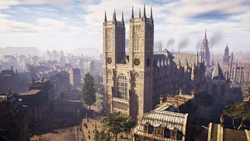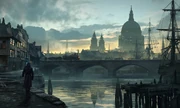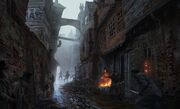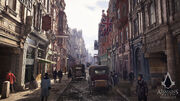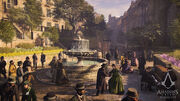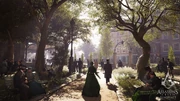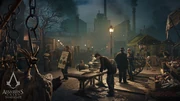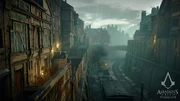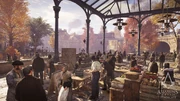(补充信息,未翻译) |
(添加分类) |
||
| 第431行: | 第431行: | ||
[[Category:港口城市]] |
[[Category:港口城市]] |
||
[[Category:伦敦]] |
[[Category:伦敦]] |
||
| + | [[Category:刺客信条:英灵殿地点]] |
||
2020年6月6日 (六) 13:08的版本
| 兄弟会需要你的帮助! 本条目包含未翻译内容。您可以帮助刺客信条维基来 翻译这个条目。 |

|
耐心点,兄弟们。不久我们就会揭开Assassin's Creed: Syndicate, Assassin's Creed: Underworld and Assassin's Creed: Conspiracies的秘密。 这篇文章被确认过时了。请更新这篇文章,以使它符合最新的涵义。完成之后,就移除这个模板吧。 |
London is a city in southern England, and the current capital of the United Kingdom.
History
Roman era
During the 1st century CE, the Romans settled the town of Londinium. The wall that ran around the settlement had six gates built into it; one of them was named after King Lud, who ruled pre-Roman Britain around 66 CE. The adjoining hill was also named Ludgate.[1]
The Roman settlement became the bulk of what would be known as the City of London.
Middle Ages
In 604, the first St Paul' church was built but burn down 71 years later.[2]
During the 10th century, King Edgar the Peaceful gave to King Kenneth III of Scotland a plot of land and the castle to serve as the residence for the Scottish monarchy whenever they visited London.[3]
When Edward the Confessor successfully drove the Danes from England in the 11th century, he rebuilt a Saxon church of Westminster in the Romanesque style to show his gratitude to God and the Pope.[4] Edward also built St. Margaret's church to accommodate the growing populace.[5]
When the Normans conquered England in 1066, William the Conqueror was coronated the day of Christmas in Westminster church which became the personal church of English monarchy and the site of their coronations.[4] In 1087, the chaplain to William the Conqueror built the St. Paul's Cathedral out of stone.[2]
At the end of the 11th century, King William II built a palace at Westminster which became the royal residence.[6]
In 1123, the Anglo-Roman monk Rahere fell ill while on a pilgrimage to Rome and vowed to found a hospital if he survived. His vow led to the construction of the St. Bartholomew's Hospital, the oldest of the city.[7]
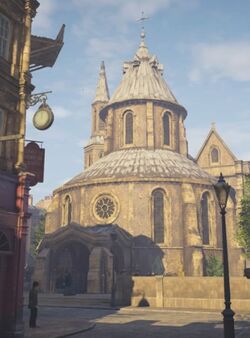
Temple Church
In 1185, the Temple Church was built and was consecrated by Heraclius, the Patriarch of Jerusalem Vault. The church was originally part of a larger monastic complex that included residences, military training grounds, and places for recreation. The Knight Templars used the church for initiation ceremonies, which would be held in a crypt beneath the nave. The church also served as a bank for the nobility, and this, combined with an influx of gifts from the royal family, made the Knights Templar very wealthy.[8]
In 1197, the hospital of St. Mary's Spittle was built in Spitalfields.[9]
During the 13th century, Lambeth Palace became the London residence of the Archbishop of Canterbury, leader of the Church of England. The first Archbishop to take up residency in Lambeth Palace was Stephen Langton, a key player in the signing of the Magna Carta in 1215.[10]
When King Henry III took the throne, he rebuilt the Westminster church in a Gothic style as a tribute to Edward the Confessor. To pay for the project, Henry had to divert funds from the kingdom, which people at the time didn't appreciate.[4]
In 1267, St. James's Hospital specialized in treating female lepers. The patients worked on the marshy land around the hospital as a part of their treatment, primarily raising hogs for the hospital to sell.[11]
In 1286, a white chapel was built, giving the name of Whitechapel to the borough. It was reconstructed in 1329, when it was officially named St. Mary Matfelon.[12]
Renaissance

King Henry VII
During the time of the mid-Renaissance, London was ruled by King Henry VII of England. During the late 15th century, the British Rite of the Templar Order made attempts to obtain the English throne. However, their plans were thwarted by Henry VII, as he imprisoned Lambert Simnel and had Perkin Warbeck hanged. In 1503, Ezio Auditore da Firenze, Mentor of the Italian Assassins, sent a group of his apprentices to London in order to aid King Henry VII. They subsequently killed Warbeck and Simnel's co-conspirator Margaret of York in November of 1503.[13][14]
Afterwards, the apprentices killed several Templars instigating riots over Margaret's death. One such Templar revealed that their Order had infiltrated Henry's Star Chamber, to which the apprentices quickly searched for the infiltrators; they found a group of Englishmen signing Borgia documents and eliminated them. As a reward, King Henry offered the Assassins a seat in the Star Chamber.[13][14]
During the 16th century, the Ludgate was renovated and enhanced by sculptures of King Lud and his sons.[1] The Tudor dynasty held extravagant jousting tournaments on the tiltyard of the Palace of Westminster that were reportedly attended by thousands of spectators. The tiltyard was also used for fireworks and bear-baiting matches.[15]
In 1513, a horseferry owned by the Archbishop of Canterbury ran between Lambeth Palace and Westminster.[16]
The reign of Henry VIII greatly modified the power of the King of England. In 1530, he moved the royal residence from Westminster Palace to Whitehall. Westminster became the permanent location for the country's two houses of parliament, the House of Commons and the House of Lords. The Courts of Law were also established in Westminster.[6] In 1532, Henry acquired the land of the former St. James's Hospital to use it as a hunting ground, making the oldest of London's Royal Parks.[11] In 1534, when Henry severed ties with the Catholic Church and St. Paul's became a Protestant cathedral[2] and in 1536, Henry seized Covent Garden which was tilted to Benedictine monks and the land was given to the Earl of Bedford.[17] In 1542, Henry ordered the construction of St. Martin-in-the-Fields as he wanted to redirect the funeral processions of plague victims away from his home at Whitehall.[18]
Henry's daughter, Mary I restored Catholicism in England, and St. Paul's went back to Catholic worship.[2] In 1554, as Mary announced her impending marriage to Philip II of Spain, Sir Thomas Wyatt led a rebellion against the Queen. Wyatt's men met Mary's troops in Charing village, and the ensuing battle resulted in Wyatt surrendering.[19] As Mary was back by the Templars, the British Brotherhood of Assassins killed the Queen in 1558.[20]
Mary's half-sister Elizabeth who possessed an Apple of Eden[20], became the new Queen of England and St. Paul's became Protestant once again as Elizabeth restored the Protestantism.[2] During her reign, Elizabeth used St. James's Park to host her lavish parties.[11]
In 1570, Thomas Gresham invested in the construction of the Royal Exchange, a centre for trade was inspired by the Brouse in Antwerp in Belgium. As Antwerp was raided by the Spanish ten years later, losing the nation's wealth and allowing England to take over as the new financial power.[21]
In 1581, Queen Elizabeth gave to Sir Thomas Knyvet a residence in the borough of Westminster.[22]
In 1594, Queen Elizabeth's chief physician Roderigo Lopez was arrested after attempting to poison the Queen. He was hanged, drawn, and quartered in June of that year.[7]
After the unification of the crown of England and Scotland, the palace of Great Scotland Yard was demolished and a series of government buildings and residences were built in its place.[3]
King James invested in the St. James's Park, adding gardens and a menagerie of exotic animals.[11]
In 1605, the Catholic extremist Guy Fawkes attempted to blow up the Houses of Parliament. He was arrested by Sir Thomas Knyvet[22] and tried in the very place he tried to destroy before being executed.[6]
In 1610, the Lambeth Palace opened its library to the public.[10]
Since 1614, the House of Commons and the Speaker have attended mass at St. Margaret's and sermons were traditionally given by the Speaker's chaplain.[5]
In 1622, Inigo Jones designed a Banqueting Hall for Whitehall Palace. The Hall was used by King James I to host receptions and performances that combined poetry, music, dance, and costumes. These performances, or masques, were a trademark of the Stuart dynasty and often promoted the divine power of the monarchy.[23]
In 1624, George Villiers, the first Duke of Buckingham had acquired the illustrious York House from the Archbishop of York. Two years later, he built the Watergate and he wanted his new home to be accessible from the river.[24]
In 1627, the 4th Earl of Bedford hired Inigo Jones to design and build a piazza at Covent Garden. The project inspired by the piazzas of Italy and the first of its kind in England, was completed in 1631.[17]
In the 1630's, King James I commissioned Lincoln's Inn Fields to improve the city.[25] Robert Sidney, the Earl of Leicester, purchased from the government a portion of land where he built Leicester Square and the adjoining Leicester House.[26]
In 1633, the Earl of Bedford commissioned architect Inigo Jones to construct the St. Paul's Chapel in Covent Garden, the first chapel since the Protestant Reformation.[27]
English Civil War
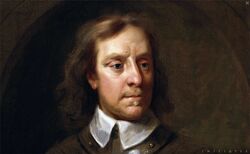
Oliver Cromwell, a leader who overthrew the monarchy
During the English Civil War, London was the place of political turmoil between the King Charles I and the Parliament. In 1641, the tiltyard of Westminster Palace was closed and a building was constructed.[15]
In 1643, parliamentarian Edmund Waller plotted to return King Charles to London, an act of betrayal to the Long Parliament. Waller's Plot was discovered by Long Parliament leader John Pym during a sermon at St. Margaret's. Pym immediately ordered the arrest of Waller and his co-conspirators from the church, and Waller was ultimately banished for his crimes.[5]
The Archbishop of Canterbury was stripped of his possessions by the Parliament. The Lambeth Palace was damaged[10] and the horseferry became an important crossing for Parliament to control to keep supporters of the king out of Westminster.[16]
In 1648, Charles was tried for treason at Westminster Palace.[6] Charles made his final procession from St. James Park to Whitehall Palace, where he was executed[11] by Richard Brandon.[12]
As the Puritanism movement increased in the city, the heads of the statues of King Lud and his sons were chopped off by vandals.[1]
By 1654, a market operated at Covent Garden.[17]
Restoration era
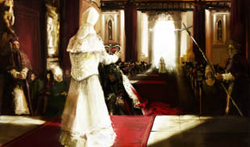
Charles II's crowning in London
In 1660, Charles Stuart was invited to London to be crowned King after having been exiled by Oliver Cromwell for several years. At his crowning, Stuart noticed a man holding a sphere wrapped in a thick piece of cloth talking with his General, George Monck.[28]
In 1660, King Charles II desired to be able to walk from Hyde Park to St. James's Park without having to take his feet off royal soil. He commissioned the creation of what he called Upper St. James's Park to bridge the gap between the parks. According to a legend, Queen Catherine ordered the flower beds in the park to be removed after discovering that Charles had picked flowers from the park to give to another woman, making the park entirely "green."[29]
The same year the Royal Society of London for Improving Natural Knowledge was founded as an assemblage of natural scientists who met weekly to discuss experiments and the promotion of the natural world.[30]
During his reign, Charles II made the Leicester Square public once again. The Square became a spot for many duels.[26]
In 1663, the Theatre Royal was built on Drury Lane, associating Covent Garden with London's theatre scene.[27]
In 1665, the first Horse Guards was built to serve as the official headquarters of the Household Cavalry Mounted Regiment, the squadron that makes up the Life Guard of the monarchy.[15]
In 1665, Sir John Denham, the poet and Surveyor General of Works designed and paid for the construction of his house. As his wife had passed and his own health was failing, Denham sold the property two years later to the Earl of Burlington. The house was known as Burlington House.[30]
The 2nd September 1666, the Great Fire of London began at a baker's shop on Pudding Lane. During four days London burned to the ground which gutted the medieval City of London inside the old Roman city wall. It threatened, but did not reach, the aristocratic district of Westminster, Charles II's Palace of Whitehall, and most of the suburban slums. It consumed 13,200 houses, 87 parish churches, St. Paul's Cathedral and most of the buildings of the City authorities. It is estimated to have destroyed the homes of 70,000 of the City's 80,000 inhabitants. The death toll is unknown but traditionally thought to have been small, as only six verified deaths were recorded. This reasoning has recently been challenged on the grounds that the deaths of poor and middle-class people were not recorded, while the heat of the fire may have cremated many victims leaving no recognizable remains. The fire cost the British government £10 million.[31]
After the Great Fire, the architect Christopher Wren was commissioned to redesign London. He redesigned St. Paul's Cathedral.[2] He also installed an organ and altar screen in the Temple Church, but more notably, he whitewashed the church's paintings and applied plaster to the marble columns in an attempt to fit aesthetic tastes of the time.[8] In 1669, Wren's Royal Exchange opened to the public as the center of the city.[21] Between 1671 and 1677, Christopher Wren built the Monument to the Great Fire of London on the site of St. Margaret's church to commemorate the tragedy.[31]
In 1670, Charles II formally granted the Earl of Bedford market rights, officially allowing the landowner to profit from the business that occurred on Covent Garden.[17]
In 1672, the Duke of Buckingham sold the York Watergate to developers and over the next few years, York House and the neighbouring mansions were torn down, with roads built in their place.[24]
In 1675, Ralph Montagu commissioned the construction of the first Montagu House.[32]
In the late 17th century, as Spitalfields became less of a field and more of a developed neighbourhood, a silk-thrower named John Balch acquired the rights to hold a market in the area every Thursday and Saturday. The market, which sold only fruits and vegetables, was a quick success. London experienced a wave of incoming French Huguenots who had just been expelled from France for their religious beliefs. Many of the French Huguenots who settles in Spitalfields were skilled silkweavers, and sold their wares at the Spitalfields Market. It wasn't long before the market became synonymous with its luxurious silk, and all of Spitalfields gained a very positive reputation as a result.[9]
In 1685, St. Mary Matfelon was rebuilt despite the fact that it was one of only a few buildings to survive the Great Fire.[12]
After the death of Charles II, St. James's Park gained a reputation for criminal activity and prostitution.[11]
When Queen Mary II took the throne, the heads of the statues of King Lud and his sons were replaced at Ludgate.[1]
At the end of the 17th century saw the nations of Europe pitted against one another in the Nine Years' War. It was an expensive war for England, and after suffering a significant naval defeat at the Battle of Beachy Head, King William III couldn't afford to rebuild their navy. Scottish merchant William Paterson who, with a handful of his colleagues, raised £1.2 million pounds from rich and poor alike in 11 days to finance the government, this was the Bank of England based in Mercer's Chapel, and those who donated were its first shareholders.[33]
In 1698, the Palace of Whitehall burned down, with the Banqueting Hall as the only building to survive. The Hall was converted to replace the Chapel Royal of Whitehall.[23]
In 1710, a scandal took place in St. Mary Matfelon, as the rector of the church set up an altarpiece depicting the Last Supper, and had the figure of Judas made to look exactly like a personal enemy of his, the Dean of Peterborough.[12]
In 1710, Queen Anne urged Parliament to pass an act allowing for the construction of fifty new churches in London. The act was passed, but only twelve of what were called Queen Anne's churches were ever built. The first Queen Anne church was St. Mary le Strand, on the former site of the largest maypole in London.[34]
Georgian era
In 1721, James Gibbs designed a new St. Martin-in-the-Fields. The construction impressed King George I who paid a total of £100 for the men who built it.[18]
In 1723, following his time as a privateer-turned-pirate in the Caribbean, the Assassin Edward Kenway retired to a spacious mansion on Queen Anne's Square, in Bloomsbury, with his wife Tessa, their son Haytham, and his daughter from his first wedding Jenny.[35]
In 1726, Thomas Ripley designed the office building of the Admiralty, which served the authority in charge of the Royal Navy. The U-shaped building contained a board room, state rooms, and apartments for the Lords of the Admiralty.[36]
In the 1730s, the Bank of England was relocated at Threadneedle Street in the City of London.[33]
In 1731, John Montagu sold the Montagu House which would become the British Museum. He bought up three adjoining plots of land in Whitehall. On these plots, he sought to build a larger, grander house than his father's of 4,300 square feet.[32]
In 1732, King George II offered to the First Prime Minister Robert Walpole the 10 Downing Street as a gift, but Walpole only accepted the offer on the condition that the house became the official residence of the Prime Minister.[22]
On 3 December, 1735, mercenaries hired by the Templar – and family friend – Reginald Birch attacked their home, murdering Edward and kidnapping Jenny. Birch then took Haytham in, training him to become a Templar.[35]
In 1735, Lincoln's Inn Fields was closed to the public by the Parliament as the square attracted beggars and vagrants.[25]
In 1739, the architect George Dance the Elder, then the Clerk of the City's Work, was hired to design and build what would be called the Mansion House, the residence of the Lord Mayor of London.[37]
In 1746, Upper St. James's Park was officially renamed Green Park.[29]
In 1748, the first House Guards was torn down after the building deteriorated to such a degree that soldiers and horses were in near-constant danger of being crushed by falling debris. In 1750, the construction of a new Horse Guards began, and the Queen's Household Cavalry moved into the building five years later. In the ensuing years, two areas of the Horse Guards gained a reputation for the non-military activities that took place there. The first was a cockfighting pit uncovered in the basement; the second was a public coffee house that attracted prostitutes.[15]
In 1749, John Montagu died and the Montagu House became the property of his daughter Mary and his son-in-law George Brudenell.[32]
In 1750, the horseferry of Lambeth Palace went out of business when Westminster Bridge was built nearby.[16]
In 1752, the Lord Mayor Sir Crispin Gascoigneto moved into the Mansion House while the House was still under construction.[37]
In 1754, Haytham attended a performance of The Beggar's Opera at the Theatre Royal to find and kill the Assassin Miko,[38] an act which saw Assassin influence in the city collapse entirely for the next 114 years.[39] Haytham recovered an artifact for Birch, who believed it was a key to a Precursor site in North America: Haytham set sail for Boston on the Providence. Meanwhile, Miko's murder became public news and left many civilians wondering whether to leave the city or not.[38]
In 1755, the MP Sir Matthew Fatherstonhaugh built his mansion in the Westminster district.[40]
In 1758, Jenny Scott returned to Queen Anne's Square after Haytham found her and rescued her from a palace in Damascus. She decided to rebuilt the Kenway Mansion and to never leave the house.[35]
In 1758, the Mansion House was completed.[37]
By 1759, the city had widened the street in front of the Admiralty, which cut into their courtyard. The Lords of the Admiralty commissioned a new façade to run along the street.[36]
In 1760, George III relocated the Royal Mews to Buckingham House[41] and buy the Mansion as a gift for his wife.[42]
In 1760, the Ludgate was demolished and replaced years later by a circular junction.[1]
Between 1760 and 1769, the Scottish engineer Robert Mylne built a bridge that connected the City of London and Southwark. This crossing was originally meant to be named Pitt Bridge in honour of the former Prime Minister William Pitt the Elder, but the name never caught on. It was named the Blackfriars Bridge.[43]
In the late 18th century, an opera house was built near Leicester Square, as well as a museum of natural curiosities called the Holophusikon, which featured many specimens collected by Captain James Cook, and Wyld's Globe, a large spherical attraction that allowed patrons to see a map of the Earth from the inside.[26]
In 1783, Fatherstonhaugh's widow sold his house to Prince Frederick, Duke of York and Albany. The Prince renovated the mansion, giving the mansion its signature portico and circular hall, before trading the property for Lord Melbourne's home in Piccadilly in 1792.[40]
During the 18th century, the Templars were able to gain complete control of the city and kept it under their thumb well into the 19th century.[44] In 1805, as Jennifer Scott passed, the Templars quietly purchased the Kenway Mansion to discovered its secrets.[45]
In 1809, a second gallery was built onto the Chapel Royal in order to accommodate larger military services.[23]
In 1811, a former employee of the Bank of England was found guilty of forgery and executed. His sister Sarah Whitehead was so traumatized by the death of her brother that she visited the bank every day for the next 25 years, asking to see her brother. This story gave to the Bank the nickname of "The Old Lady of Threadneedle Street".[33]
In 1812, Prime Minister Spencer Percival was assassinated in the lobby of the House of Commons.[6]
In 1819, Piccadilly Circus was constructed on the site of Pickadilly Hall, home of the famous seventeenth-century tailor Robert Baker on Regent Street.[46]
Around 1820, the architect Edward Blore restored the Lambeth Palace, which he qualified as "miserably deficient." before his work was done.[10]
To honor the death of the Admiral Horatio Nelson at the Battle of Trafalgar in 1805, the architect John Nash was commissioned to construct a monument on the former site of the monarchy's stables and carriage house. He built an open space for the public known as Trafalgar Square. The square was improved upon over the course of the nineteenth century, with fountains and statues giving the originally modest square some embellishment.[47]
When George IV took the throne in 1820 and set about converting Buckingham House into a palace, he commissioned John Nash to redesign the house and also the Royal Mews.[41] Nash doubled the size of the original Buckingham House, adding a new suite of rooms, demolishing the north and south wings and rebuilding them larger than before, and installing a large Marble Arch in the courtyard. Nash got so carried away with building the new palace that his budget ballooned to about half a million pounds. He was fired in 1829, and George IV died the following year, before the palace was completed. His brother William IV, oversaw the completion of Buckingham Palace but never lived there.[42]
In 1824, George IV encouraged Parliament to buy the residence of a newly deceased banker and art collector John Julius Angerstein and to transform the building in the first National Gallery of England.[48]
In 1829, Prime Minister Robert Peel created the Metropolitan Police Service. As their headquarters' rear entrance stood on Great Scotland Yard, therefore the police force became commonly known around the world as Scotland Yard.[3]
In 1830, Melbourne House was purchased by George James Welbore Agar-Ellis. A year later, Agar-Ellis became the Baron of Dover, renaming the Mansion as Dover House.[40]
In 1831, when the cholera epidemic hit London, St. Bartholomew's Hospital refused to admit cholera patients. Instead, cholera patients were kept in a nearby house which was demolished following the outbreak. A medical school was built as an extension of the hospital a few years later. The facilities were state-of-the-art, and featured a library, medical and chemical theatres, an anatomy museum, and dissection rooms.[7]
In 1832, the National Gallery was relocated on Trafalgar Square. The building was designed in a neo-classical fashion by architect William Wilkins, and its location, equidistant to both the wealthy West End and the lower-class East End, meant that people of all socio-economic backgrounds could access the museum.[48]
In 1836, the London and Greenwich Railway opened the London Bridge station. Different companies were paying the LGR to use their line and access to London.[49]
Victorian era
- “Today, Starrick sits at the helm of the most sophisticated Templar infrastructure known in the western world. Every class, every borough, the gangs, the industries - his reach extends all across London. [...] Look at what Starrick has done to this city. Whitechapel is riddled with crime. Child labor, despite regulations. A gang known as the Blighters overruns the streets. And Templars manipulating behind the scenes. As in all the other boroughs. We need to return this city to the people who built it in the first place.”
- ―Henry Green describing the state of London, 1868.[来源]
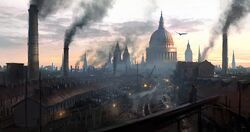
London during the Victorian era
By the 19th century, under Queen Victoria's rule, London became the global capital of invention with its technological advancement. It was divided into seven boroughs - the City of London, Lambeth, The Strand, Westminster, Southwark, Whitechapel, and the River Thames - each with a different culture but with a single commonality. As country folk moved in to the city for employment, however, it resulted in a sudden increase in population and decrease in wages, in addition to most businessmen abusing workers. These actions became a spark for the Industrial Revolution.[50]
In 1837, when Queen Victoria moved into Buckingham Palace, improvements were made to the Royal Mews. Prince Albert had a new forge installed and additional cow sheds built onto the Mews. In 1855, Queen Victoria used her own money to establish the Buckingham Palace Royal Mews School, which served to educate the children of the stable's servants. The Mews had nearly 200 employees at the time, and accommodations were built for them and their families in 1859.[41]
In 1838, the Royal Exchange was destroyed by fire. The 28th October 1844, a new Royal Exchange was opened by Queen Victoria.[21]
In June 1840, Edward Oxford attempted to assassinate Queen Victoria as her carriage passed just outside Green Park. He fired twice on the carriage, missed, and was subdued.[29]
In 1841, the Temple Church was restored by architects Sydney Smirke and Decimus Burton. Smirke and Burton's work gave the church a Victorian Gothic look that not only fit the tastes of the time but fit closely with the church's original design.[8]
In 1843, Nelson's Column was built on Trafalgar Square, costing £47,000 and measuring 155 feet tall. In 1858, the sculptor Sir Edwin Landseer was commissioned to sculpt lions at the base of the column. His statues were unveiled in 1867.[51]
In 1844, the London Brighton and South Coast Railway taking London Bridge station, demolishing it and rebuilding it all within the same year.[49]
In 1848, the London and South-Western Railway built Waterloo station to be a stopover between Southampton and the City of London. Waterloo became a high-traffic station, though, and as demand grew, additional platforms were built around the original building, which became known as the "Central station". Each new platform was built with its own entrance and booking office, and was either mislabelled or not labelled at all.[52]
St. Paul's had once again lost its lustre. Queen Victoria remarked that the cathedral was "dreary, dingy, and undevotional." Funds were raised to improve the cathedral by such philanthropists as Maria Hackett and William Weldon Champneys.[2]
In 1850, the coffee house of the Horse Guards was finally closed.[15] The same year, the architect Arthur Hayes designed the Lambeth Asylum. A year later, Hayes was killed by his son who believed his father to be the Antichrist. Arthur Hayes Jr. would later be admitted to Lambeth as a patient.[53]
In 1852, the Parliament established the London Necropolis and Mausoleum Company to create a new burial ground outside the city and ship the newly deceased from inside the city. The former task was achieved by building a 500-acre cemetery in Surrey - the largest in the world at the time - and the latter by establishing the "Necropolis Railway", a private rail line that moved all those corpses directly from Waterloo station to Surrey. Waterloo was chosen as a departure point because its location by the Thames allowed bodies to be delivered to the station from all over London.[52]
In 1854, the British government acquired Burlington House which was granted to the Royal Society.[30]
In 1854, the architect T. Hayter Lewis designed the Royal Panopticon of Science and Art, inspired by the Indo-Islamic architecture of British India. The institute went bankrupt two years later and the building was purchased by the famous circus proprietor E.T. Smith. He added a circus ring to the interior and for a short time, the Panopticon became the Alhambra Circus. Smith changed tactics in 1860, converting the circus to a theater and renaming the whole thing the Alhambra Music Hall, one of the first music halls to compete with what was considered "legitimate theatre" in London.[54]
In 1859, Walter Francis Scott demolished Montagu House. In three years' time, Scott had built in its place this French Renaissance-inspired mansion, which contemporaries called a "palatial residence." It was designed by the architect William Burn, known for the hospitals and castles he designed in his native Scotland.[32]
In 1860, Peter W. Barlow designed the Lambeth Bridge, built on the site of the original horseferry. Constructed as a toll bridge, the steep approaches on either side inadvertently discouraged horse-drawn carriages from using Lambeth Bridge.[16]
In 1861, an Act of Parliament allowed the construction Cannon Street station station by the South Eastern Railway and opened to the public September 1st, 1866. The station's hotel was built the following year, and was designed by E.M. Barry, the son of J.W. Barry, the architect behind the House of Parliament. The presence of the train station, and its proximity to the Thames, bolstered Cannon Street as a centre of trade.[55]
In 1864, Sir John Hacksaw designed Charing Cross station which was built by the South Eastern Railway, one of many train stations to spring up in the core of the city. Despite being just two miles away from London Bridge, the train line took four years to build. A total of 17 bridges and 190 arches stand between Charing Cross and London Bridge.[19]
In 1864, the Blackfriars Bridge was torn down when the government determined it would be more cost-effective to simply replace the bridge than to keep repairing it. In 1869, the new Blackfriars Bridge designed by Thomas Cubitt was completed. In his Dickens's Dictionary of London, published ten years later, Charles Dickens Jr. describes Blackfriars Bridge as "one of the handsomest in London.[43]
In 1865, St. Pancras station was built by the Midland Railway Company on a disreputable slum. Landlords were happy to sell their property for a pretty penny, and inhabitants of the neighborhood were driven out of their homes without compensation. Building the station required moving a church and excavating its graveyard. The Midland Railway Company held a contest to find the best design for a hotel the company intended to attach to the station. The winner was the architect Sir George Gilbert Scott, despite - or perhaps because - his submission was greater and more expensive than the specifications the MRC called for. The first train to leave St. Pancras in 1868 was bound for Manchester and did not stop until it reached Leicester, 97 miles away. At the time, it was the longest continual train run in the world. I bet it never stopped there again.[56]
By 1860, London had fell under the control of the Templar Grand Master Crawford Starrick, who used his network of Templar agents to control the city and oppress the working classes to keep the Templars in power. The British Assassins, particularly Henry Green worked to reclaim power in the city. He enlisted the aid of the fraternal twins Jacob and Evie Frye, who created the gang known as the Rooks to remove the influence of the Templar-backed gangs throughout London.[57][39]
In February 1868, Prime Minister Benjamin Disraeli convinced Parliament to pay to renovate 10 Downing Street, although Disraeli had to pay out of pocket to refurbish the private rooms.[22]
In January of 1869, Lambeth asylum closed its doors due to the death of its sole benefactor, Crawford Starrick. However, Lambeth was reopened a year later and partially rehabilitated to receive a growing number of violent criminals. The vast majority of these 'dangerous criminals' came from among London's most destitute populations in the borough of Whitechapel.[58] In 1870, a wing of Lambeth Asylum was converted for use as a maximum security psychiatric ward for the violent criminals and was known as the gaol wing. The treatments as the Rotary Chair, solitary confinement and even the Electric Chair were common practices in the G wing.[59]
In 1869, another train station named Waterloo Junction was built across the street near Waterloo station.[52]
In November of 1869, Queen Victoria officially unveiled the Holborn viaduct which was built to span the length of the old Fleet River and work was put in to make the bridge not just a necessity of infrastructure, but an artful piece of city design.[60]
In 1870, the Thames Embankment was completed and its gardens were created around the York Watergate in 1874.[24]
In 1870, a young boy known as Jack the Lad was sent to Lambeth Asylum by the Templars who killed his mother before him. During a year, the young boy suffered from poor treatments and negligence from the doctor of the G wing. Jacob Frye liberated Jack and inducted him in the Brotherhood.[61]
In 1875, St. Mary Matfelon was rebuilt again in order to more closely resemble the church as it was in 1329.[12]
In 1875, the Spitalfields market lease passed to a developer named Robert Horner. Horner fought regularly with the Whitechapel District Board of Works over how the market could be expanded without disturbing traffic around the market.[9]
In 1877, the Metropolitan Board of Works bought the Lambeth Bridge which ceased to charge tolls.[16]
In the 1880s, the shape of Piccadilly changed when Shaftesbury Avenue was created and cut through the circle.[46]
In 1883, an iron and glass roof was built over Spitalfields market, and the surrounding shops were built over the next century.[9] By the nineteenth century, the silkmakers of Spitalfields market had long moved on, and overpopulation and poverty led to a rise in crime. The market remained an important fixture, providing the food needed to get through the day to those who could afford it.[9]
In 1885, Dover House became the home of the Scotland Office, a government department under the umbrella of the Department of Justice dedicated to the needs of the Scottish people.[40]
In 1891, the Chapel Royal was converted into a museum with Queen Victoria's approval.[23]
In 1893, the York Watergate was acquired by the London County Council as an object of public interest.[24] Two years later, the Council also acquired Lincoln's Inn Fields which was opened for the public.[25]
20th century
In 1908, Prime Ministers were legally required to live at 10 Downing Street.[22]
In 1916 during the First World War, a German individual and a Sage known as the Master Spy infiltrated London, setting up a spy network near the Tower Bridge as well as a localized cult in service of Juno. Winston Churchill caught wind of his activities and enlisted the help of the Assassin Lydia Frye, who succeeded in repelling the enemy planes and eliminating the spy cell.[39]
In 1917, the British government acquired the Montagu House and converted into office space.[32]
In 1932, the Lambeth Bridge was rebuilt as the suspension cables and girders were rusted.[16]
During World War II, London was greatly destroyed by the Blitz. St. Mary Matfelon was hit hard during the conflict.[12]
In 1950, the Montagu House was demolished.[32]
In 1952, St. Mary Matfelon was demolished.[12]
In 1964, the Admiralty became the home of the newly established Department for International Development.[36]
In 1974, the Covent Garden Market was moved to a new location south of the Thames.[17]
21st century
In October 2016, Simon Hathaway was inducted into the Templar's Inner Sanctum.[62] Simon used an Animus to relive the memories of his ancestor, Gabriel Laxart, in order to find a way to repair the Sword of Eden Rikkin had in his possession.[63] Ten days later, Hathaway was brought to trial for going behind the Order's back. However all the charges brought against him were dropped after his speech and that his shady actions were in fact carried out for the benefit of the Templar Order.[64] In December, after discovering Aguilar's Apple, Alan Rikkin called a meeting with the Council of Elders in London at the Grand Templar Hall. While presenting the Apple's abilities, Alan was assassinated by Callum Lynch who took the Apple and fled.[65]
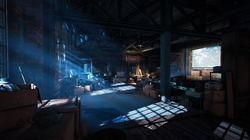
Layla's hideout
In late-2018, Layla Hassan and her team were stationed in a loft apartment in London while searching the memories of the Spartan misthios Kassandra in order to locate more Isu artifacts before Abstergo could. Kiyoshi Takakura, a member of the team kept watching from outside. Eventually, the cell's location was identified by Abstergo and so they were forced to flee, though not before Layla left a USB drive at the apartment that could be remotely scanned and infect secure computer systems, such as that held by the Head of Operations at Abstergo.[66]
Districts
During the Industrial Revolution, London was divided into seven boroughs.
City of Lodon
- 主要词条: City of London
On the right bank of the Thames, with its high and elegant buildings, the City is the financial center of London comprising the Bank of England and the Royal Exchange. One of its most notable landmarks are the St. Paul's Cathedral and the Monument to the Great Fire of London.
Lambeth
- 主要词条: Lambeth
The most rural borough of London, the district of Lambeth is composed of many small houses and market places in the South of London. Its most notable monuments are the Lambeth Palace and the Asylum.
River Thames
- 主要词条: River Thames
The River Thames has an economic value as many Riverboats transported products and merchandise between the docks and markets. The left and right banks of the Thames are connected by many bridges as the London Bridge and the Westminster Bridge.
Southwark
- 主要词条: Southwark
As the industrial heart of London, Southwark as many factories, docks and brick houses for the workers. One of its most notable landmarks is the Waterloo station.
The Strand
- 主要词条: The Strand
The Strand is the cultural district of London with the British Museum and the Alhambra Music Hall. It is also an important place for shopping activities. It has an elegant architecture and a lot of parks. The Metropolitan Police Service has its headquarters located at Scotland Yard.
Westminster
- 主要词条: Westminster
One of the richest districts, Westminster his the political center of London with the Royal Residence of Buckingham Palace, the Prime Minister house at the 10 Downing Street and the Chamber of the Parliament at the Palace of Westminster. Westminster has also many religious monuments as Westminster Abbey and the Temple Church. The Slum of Devil's Acre contrast with the green parks and the wealth of the district.
Whitechapel
- 主要词条: Whitechapel
Named after a chapel St. Mary Matfelon, Whitechapel is the poorest district of London, with slums, prostitution and thievery. During the year 1888, the district became infamous for the murders of the serial killer Jack the Ripper. One of its most notable infrastructure is the Spitalfields Market.
Trivia
- There are light bulb advertisement signs on some buildings in Assassin's Creed: Syndicate, though this is anachronistic as electric lighting was first used in 1883 in Holborn.[67] The first light bulb advertisement signs didn't appear until at least the 1890s.[68]
- Many of the roofs of the buildings in Assassin's Creed: Syndicate, are in the Mansard style. This style spread to Britain in the 18th century.[69][70][71] Some of the roofs are covered with metal tiles, either lead, corrugated iron, a method originally patented in England in 1829 or zinc galvanized metal, a method developed in France in 1837[72] and which became popular in Victorian times, because of its cheapness when compared with lead.[73]
- The sewers of London share the same model as the sewers of Paris from Unity.
Gallery
Appearances
- Assassin's Creed: Project Legacy
- Assassin's Creed: Brotherhood (仅提及)
- Assassin's Creed III (首次登场)
- Assassin's Creed: Forsaken
- Assassin's Creed: Syndicate
- Assassin's Creed: Underworld
- Assassin's Creed: Heresy
- Assassin's Creed: The Movie
- Assassin's Creed: Conspiracies
- Assassin's Creed: Odyssey
- Assassin's Creed: Gold
- Assassin's Creed: Valhalla
References
- ↑ 1.0 1.1 1.2 1.3 1.4 Assassin's Creed: Syndicate – Database: Ludgate Circus
- ↑ 2.0 2.1 2.2 2.3 2.4 2.5 2.6 Assassin's Creed: Syndicate – Database: St. Paul's Cathedral
- ↑ 3.0 3.1 3.2 Assassin's Creed: Syndicate – Database: Scotland Yard
- ↑ 4.0 4.1 4.2 Assassin's Creed: Syndicate – Database: Westminster Abbey
- ↑ 5.0 5.1 5.2 Assassin's Creed: Syndicate – Database: St. Margaret's, Westminster
- ↑ 6.0 6.1 6.2 6.3 6.4 Assassin's Creed: Syndicate – Database: Houses of Parliament
- ↑ 7.0 7.1 7.2 Assassin's Creed: Syndicate – Database: St. Bartholomew's Hospital
- ↑ 8.0 8.1 8.2 Assassin's Creed: Syndicate – Database: Temple Church
- ↑ 9.0 9.1 9.2 9.3 9.4 Assassin's Creed: Syndicate – Database: Temple Church
- ↑ 10.0 10.1 10.2 10.3 Assassin's Creed: Syndicate – Database: Lambeth Palace
- ↑ 11.0 11.1 11.2 11.3 11.4 11.5 Assassin's Creed: Syndicate – Database: St. James's Park
- ↑ 12.0 12.1 12.2 12.3 12.4 12.5 12.6 Assassin's Creed: Syndicate – Database: St. Mary Matfelon
- ↑ 13.0 13.1 Assassin's Creed: Brotherhood – Contracts
- ↑ 14.0 14.1 Assassin's Creed: Project Legacy – Contracts
- ↑ 15.0 15.1 15.2 15.3 15.4 Assassin's Creed: Syndicate – Database: Horse Guards
- ↑ 16.0 16.1 16.2 16.3 16.4 16.5 Assassin's Creed: Syndicate – Database: Lambeth Bridge
- ↑ 17.0 17.1 17.2 17.3 17.4 Assassin's Creed: Syndicate – Database: Covent Garden
- ↑ 18.0 18.1 Assassin's Creed: Syndicate – Database: St. Martin-in-the-Fields
- ↑ 19.0 19.1 Assassin's Creed: Syndicate – Database: Charing Cross Station
- ↑ 20.0 20.1 Assassin's Creed II – Glyphs
- ↑ 21.0 21.1 21.2 Assassin's Creed: Syndicate – Database: Royal Exchange
- ↑ 22.0 22.1 22.2 22.3 22.4 Assassin's Creed: Syndicate – Database: 10 Downing Street
- ↑ 23.0 23.1 23.2 23.3 Assassin's Creed: Syndicate – Database: Chapel Royal
- ↑ 24.0 24.1 24.2 24.3 Assassin's Creed: Syndicate – Database: York Watergate
- ↑ 25.0 25.1 25.2 Assassin's Creed: Syndicate – Database: Lincoln's Inn Fields
- ↑ 26.0 26.1 26.2 Assassin's Creed: Syndicate – Database: Leicester Square
- ↑ 27.0 27.1 Assassin's Creed: Syndicate – Database: St. Paul's, Covent Garden
- ↑ Assassin's Creed: Project Legacy – Holidays: Chapter 1 – Ghosts of Christmas Past
- ↑ 29.0 29.1 29.2 Assassin's Creed: Syndicate – Database: Green Park
- ↑ 30.0 30.1 30.2 Assassin's Creed: Syndicate – Database: Royal Society Buildings
- ↑ 31.0 31.1 Assassin's Creed: Syndicate – Database: Monument to the Great Fire of London
- ↑ 32.0 32.1 32.2 32.3 32.4 32.5 Assassin's Creed: Syndicate – Database: Montagu House
- ↑ 33.0 33.1 33.2 Assassin's Creed: Syndicate – Database: Bank of England
- ↑ Assassin's Creed: Syndicate – Database: St. Mary le Strand
- ↑ 35.0 35.1 35.2 Assassin's Creed: Forsaken
- ↑ 36.0 36.1 36.2 Assassin's Creed: Syndicate – Database: The Admiralty
- ↑ 37.0 37.1 37.2 Assassin's Creed: Syndicate – Database: Mansion House
- ↑ 38.0 38.1 Assassin's Creed III
- ↑ 39.0 39.1 39.2 Assassin's Creed: Syndicate
- ↑ 40.0 40.1 40.2 40.3 Assassin's Creed: Syndicate – Database: Dover House
- ↑ 41.0 41.1 41.2 Assassin's Creed: Syndicate – Database: The Royal Mews
- ↑ 42.0 42.1 Assassin's Creed: Syndicate – Database: Buckingham Palace
- ↑ 43.0 43.1 Assassin's Creed: Syndicate – Database: Blackfriars Bridge
- ↑ The Network Podcast - Episode 13
- ↑ Assassin's Creed: Syndicate – Database: Kenway Mansion
- ↑ 46.0 46.1 Assassin's Creed: Syndicate – Database: Piccadilly Circus
- ↑ Assassin's Creed: Syndicate – Database: Trafalgar Square
- ↑ 48.0 48.1 Assassin's Creed: Syndicate – Database: National Gallery
- ↑ 49.0 49.1 Assassin's Creed: Syndicate – Database: London Bridge Station
- ↑ Assassin's Creed official website
- ↑ Assassin's Creed: Syndicate – Database: Nelson's Column
- ↑ 52.0 52.1 52.2 Assassin's Creed: Syndicate – Database: Waterloo Station
- ↑ Assassin's Creed: Syndicate – Database: Lambeth Asylum
- ↑ Assassin's Creed: Syndicate – Database: Alhambra Music Hall
- ↑ Assassin's Creed: Syndicate – Database: Cannon Street Station
- ↑ Assassin's Creed: Syndicate – Database: St. Pancras Station
- ↑ GameInformer: Five Things to Know About Assassin's Creed: Syndicate
- ↑ Assassin's Creed: Syndicate – Jack the Ripper – Database: The Imprisoned Criminals
- ↑ Assassin's Creed: Syndicate – Jack the Ripper – Database: The Imprisoned Criminals
- ↑ Assassin's Creed: Syndicate – Database: Holborn Viaduct
- ↑ Assassin's Creed: Syndicate – Jack the Ripper
- ↑ Assassin's Creed: Heresy – Chapter 1
- ↑ Assassin's Creed: Heresy – Chapter 3
- ↑ Assassin's Creed: Heresy – Chapter 35
- ↑ Assassin's Creed: The Movie
- ↑ Assassin's Creed: Odyssey
- ↑ A Brief History of London, England. www.localhistories.org. Accessed 1 October 2017.
- ↑ See Photos Of London When Queen Victoria Was Ruling. Londonist Ltd. Accessed 1 October 2017.
- ↑ ROOFS A Guide to Alterations and Extensions on Domestic Buildings. City of Westminster Department of Planning and City Development, Development Planning Services, March 1995. Accessed 22 October 2017.
- ↑ London Terrace Houses 1660-1860. English Heritage, 23 Savile Row, London W1X 1AB 0171 973 3434 February 1996. Accessed 22 October 2017.
- ↑ London: An Architectural History by Anthony Sutcliffe. Yale University Press New Haven and London. Accessed 22 October 2017.
- ↑ Preservation Bried 4: Roofing for Historic Buildings by Sarah M. Sweetser. www.nps.gov. Accessed 22 October 2017.
- ↑ Understanding Housing Defects by Duncan Marshall, Derek Worthing, Roger Heath, Nigel Dann. Routledge 2 Park Square, Milton Park, Abingdon, Oxon OX14 4RN. Accessed 22 October 2017.
| |||||||||||||||||||||||||
| ||||||||||||||||||||||||||||||||||
| ||||||||||||||||||||||||||||
| ||||||||||||||||||||||||||||||||||||||||
| |||||||||||||||||||||||||
| |||||||||||||||||||||||||||||||||||||
| ||||||||||||||||||||||||||||
| |||||||||||||||||||||||||
| ||||||||||||||||||||
| ||||||||||||||||||||||||||||
| |||||||||||||||||
| ||||||||||||||
| |||||||||||||||||||||||||
| ||||||||||||||||||||||||||||||||||
| ||||||||||||||||||||
| |||||||||||||||||
| |||||||||||||||||||||||||||||||||||||||||||||||||||||||


